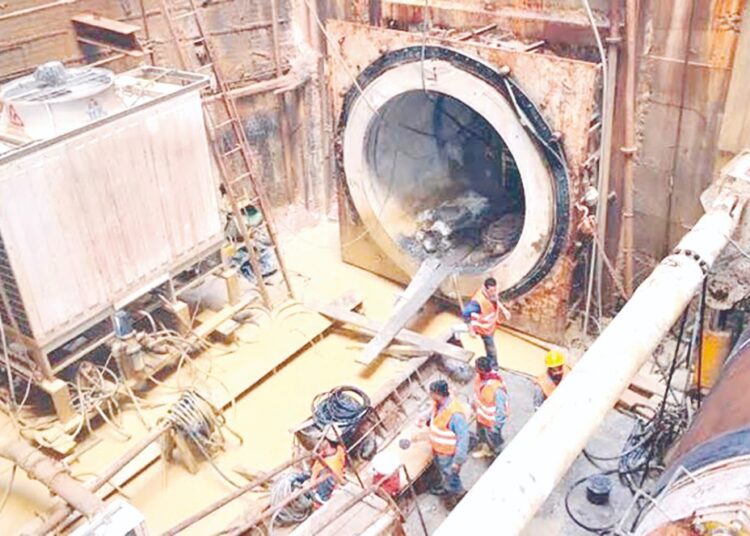Bearing in mind that developing water sector is a pre-requisite for Egypt’s sustainable development, a robust plan has been put to develop this vital resource.
Within the framework of the policy of the Ministry of Water Resources and Irrigation towards meeting the water needs of all sectors, the ministry set a water policy based on scientific and objective foundations to meet the current and future water needs of all sectors.

Many projects have been implemented, besides taking numerous measures with the aim of maximising the benefits of available water resources in addition to developing the whole water sector, which will help address the growing water challenges and adapt to changing conditions.
Water-related projects came as part of the numerous achievements implemented in most sectors since President Abdel Fattah El Sisi assumed post seven years ago.
Canal Lining Project
The Canal Rehabilitation and Lining Project has witnessing very high implementation rates. Minister of Irrigation Mohamed Abdel-Aty explained that the project will rationalise the use of water resources, one of the goals of Egypt’s national water resources strategy, intended to resolve Egypt’s water-related issues by the year 2037.
The project is part of the National Project for Developing the Egyptian Countryside aimed at raising the quality of life of residents of rural areas. The lining of canals would enhance water management and distribution, ensure the delivery of water to the ends of canals, and prevent pollution.
The ministry is committed to rehabilitation work on total length of 8,239 kilometres at a total cost LE26 billion. The rehabilitation process is to be finalised by June 2022. The total lengths of rehabilitated canals reached 1,760 kilometres. Work is underway to rehabilitate another 3,600 kilometres.

Combatting Nile encroachments
The River Nile has been exposed to many violations including building violations and encroachments on the lands of the river. The most important accomplishment in this sector was the signing of Nile Document in 2015 by President Sisi to protect the Reiver Nile and remove all encroachments.
The document gave the green light to a national campaign to preserving the river from any infringements and pollution. The Ministry of Water Resources and Irrigation stepped up efforts to eliminate all violations and punish violators in a zero-tolerance policy in accordance with the law. After the signing of the Nile Document, the Ministry of Irrigation monitored 450,000 encroachments, which increased during the removal campaigns to 500,000.
Ahl Masr Walkway
“Mamsha Ahl Masr” (Walkway for the people of Egypt) project will provide Nile parks, prevent Nile encroachments, reduce water loss and confront the issue of siltation and bridge scour as a result of human and development activities along the river. The first and second stages of the project were finalised with 1,188-metre-long walkways from Kasr el-Nil Bridge to May 15 Bridge. They were financed by Cairo Governorate.
The third stage is now underway with 1,600-metre-long walkways from May 15 Bridge to Imbaba Bridge at a cost of LE9.5 million paid by the National Bank of Egypt.

Expansion of modern irrigation systems
The ministry has implemented project to expand the use of modern irrigation systems. This project seeks to improve the efficiency of water transfer besides ensuring fairness in water distribution and boosting agricultural productivity.
Execution of modern irrigation works in covered 320,000 feddans (acres) during the fiscal year 2021-2020 in the governorates of Aswan, Minya, Beni Sueif, Fayoum, Alexandria, Matrouh and North Sinai, bringing the total that has been implemented to 346,000 feddans.
Protection of Egypt’s coastlines
The ministry has already started several coastal protection activities to protect Egyptian shores from the dangers of climate change impacts, which include countering the increase in erosion rates. Protection work has been carried out for beaches with a length of 67.6 kilometres costing a total LE 2.5 billion in the governorates of Alexandria, Marsa Matrouh, Kafr el-Sheikh, Beheira, Dakahlia, Port Said and SouthSinai.

Flood protection projects
Egypt has implemented projects to protect against floods and raise the efficiency of drains and canals. In 2014, the ministry adopted a five-year plan to make the best use of flood waters in view of growing water demand by directing rainwater to underground reservoirs and provide water to local communities and surrounding villages. The LE4.6-billion plan targeted those governorates hit badly by floods. The total number of works carried out to protect from the dangers of floods reached 1,066, which include the building of 604 dams, dirt barriers, artificial lakes and tanks in addition to 462 ground tanks in the governorates of North and South Sinai and Matrouh.
New Assiut barrage
Built over six years at a cost of LE6.5 billion, this project was carried out by a consortium of international and national companies. The New Assiut barrage includes a hydroelectric power station that produces 32 megawatts, which amounts to LE100 million annually.
The project contributes to improving the irrigation situation in an area of 1.65 million feddans in five governorates and developing river navigation through the establishment of two locks at the highest technical level standards.
It is located 400 metres away from the old Assiout barriers with two navigation locks on the right bank of the Nile, and eight sluices 17 metres wide, subdivided into three sluices on the right side of the power station and another five on the left side, allowing water to flow to the other side throughout the year according to different needs.
The total cost of projects implemented by the sector hit LE10 billion, while the cost of periodic maintenance annually costs LE40 million.
Another important project is the signing of a 57-million-dollar loan agreement with the Japanese government to build New Dayrout Barrage.






Discussion about this post